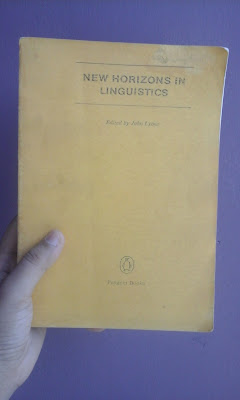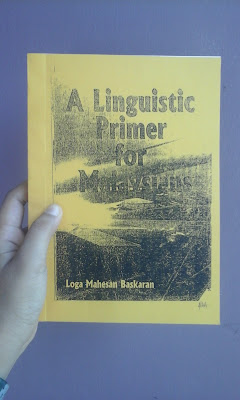Yuhuuu…
Hi
my beloved readers, today I want to let you know about linguistics. Honestly,
it is just an introduction to linguistics that I read from the books. I hope
this post will help you to know what the linguistic is.
Before knowing the linguistics, we
must know what the language is first. Language can be seen as sound organized
into units of form and function with meaning, contextualized in reality.
Language can also considered as an abstraction resultant from the linguistic
behavior of its users. So, to describe this abstraction we need a science of
language – a systematic study of language. This is what is known as LINGUISTICS
– that scientific, systematic, objective study of language. In a simple
sentence, LINGUISTICS may be defined
as the scientific study of human language. Linguistic devided into two, there
are pure linguistic and applied linguistic.
A.
Pure
Linguistics
The branches of pure linguistic are
phonetics, phonology, morphology, syntax, lexicology, and semantics.
1.
Phonetics
From the first
cry sounds that a baby give after they was born, the communication channel is
open between this individual and the world around them. The new-born infant
being totally normal produces sounds which seem meaningless to those who speak
a fully developed language. To this individual (infant) however, this
meaningless sounds are means communication with those around him.
When
he/she is hungry, wet, uncomfortable, cold, or thirsty, the only means of
conveying this message is by crying. Thus, this production of meaningless sounds (which do not have
vocabulary meaning in any language) is the first stage of communication with
the world. It also signifies the first stage of language acquisition albeit
through sounds only with no conscious effort on anybody’s part to teach this infant
to do so.
The
technical perspective that we can parallel this stage to be the field of phonetics which is the study of the production,
transmission and reception of sound. The ability to produce sounds clearly and
with no defect is due to the vocal to the vocal apparatus that is
physiologically wholesome and with no
defects. So, phonetics is the field
of linguistic science which is concerned with how these sounds are produce,
what kinds of sounds are produced, and how these sounds are received and
represented via symbols in languages in general.
2.
Phonology
The next stage
in the language acquisition process is when the infant combines some sounds to
produce syllables or parts of syllables which have some meaningful intent. For
example /mʌ/ is almost a universal syllable which
first appears in such situation. The infant produces the combination of /m/ and
/ʌ/ sounds to produce “ma” /mʌ/ which is, in the most languages, the first
syllable of the word “Mama” or “Mummy” or “Amma” meaning mother.
This
stage of language acquisition can be technically paralleled to the field of phonology which is the study of speech
sounds called phonemes – in their combinations which are specific to a
language.
3.
Morphology
The
next acquisition as the months roll on the infant is exposed to more language
around him/her, is when they can give some form to this combination of sounds.
They can say “Mama” now (not just “ma”). So the syllable that was used before
now becomes a word. This syllable could be just one syllable which can also
stands as a word. This grammatical units called morphemes. Morphemes can stand as a word on its own or combines
with another morphemes to form a word such as “Mama”.
The
technical study of thus aspect of language is associated with such morphemes,
which have their respective grammatical functions. The field is known as morphology, which differentiates the
various kinds of morphemes based on their finer grammatical functions.
4.
Syntax
The next stage
is reflective of the arrangement of words according to the rules of word –
ordering in that language. The linguistic field, associated with this field is
known as syntax. Syntax concerned
with the arrangement and ordering of words according to the rules of that
language. From words, there is the progression to phrase, clauses, and
sentences.
5.
Lexicology
Almost after
this acquisition, the individual gradually gets to increase his vocabulary.
This stage of vocabulary extension where the individual gets to widen his
meaning range and repertoire is known as lexicology. Lexicology is the study of vocabulary items of a language. Such
items are known as lexemes; or the
lexis of the language.
6.
Semantics
The aspect of
vocabulary extension where meaning goes further than just the first initial
source referent and even touches aspects metaphors and idioms is covered in the
study of linguistics called semantics. In
a simple sentence, semantics means
the meaning system of the word.
B.
Applied
Linguistics
Applied
linguistics formed by the times, psycholinguistics and sociolinguistics. Applied
linguitisc also grow as long as the time.
1.
Psycholinguistics
Psycholinguistics
is
a study that concerned with human language and the human brain. It look at how
language is acquired by the brain and what mental processes take place in
acquisition of language in normal circumstances, abnormal, or breakdown
conditions in the system are also considered under the study of
psycholinguistics. So,the study involves the effects of injury, disease,
congenital malformation and any such causes of dysfunction which affect the
speech and language of individual.
2.
Sociolinguistics
Sociolinguistics
is
the study of language as part of culture and society. Sociolinguistics studies
the variety in language and the uses to which people put language – including the
social factors.
References :
Baskaran, Loga Mahesa.2005. A Linguistics Primer for Malaysians. Kuala Lumpur : University of Malaya Press.
Lyons, John.1970. New Horizons in Linguistics. England : Penguin Books.
Thankyou
for visiting my blog I hope it will useful for you and I’m sorry if there is a mistake (typo) on this post. Aha,
and don’t forget to find and follow me on instagram and twitter.


